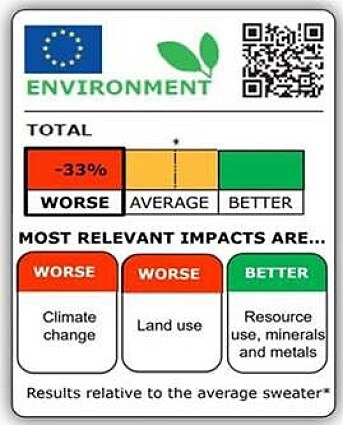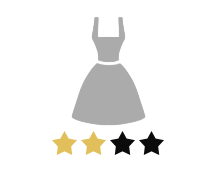wrote:
Vocabulary.
🢒 Product Environmental Footprint (PEF) - Includes resource use and emission profile (as far as I'm understanding it) for the specific items in the clothing and shoe industry.
🢒 Environmentally friendly (in this context) - has a low emission and resource profile
🢒 Non-environmentally friendly (in this context) - has high GHG emission and resource profile.
🢒 Utmark - forests, mountains, coast areas, etc. where everyone have protected rights to use and travel.
EU is working on a new way to mark clothes. It's set to be launched in 2024. It's supposed to show the consumer how "environmentally friendly" the clothing they are buying are. It does not account for all spheres of the life of a garment, and thus will rate plastic as environmentally friendly, while e.g. wool and other nature materials will be not environmentally friendly. In Norway, the critique of this already hit last fall when they realized the Bunad, the German Lezerhosten and similarly composed costumes, will be rated as "not environmentally friendly." This is not unexpected because most natural fibers have a higher impact on the environment upfront than what comes from plastic, especially if they are animal-derived. However, there are still clear issues\weaknesses with a system like this:
- The biggest issue with this labeling is that it does not take the entire lifespan of a garment into account. For the consumer, their largest action of contribution is longevity (impact per wear). To wear a garment out, to fix, adjust and repair until a garment until cannot be worn any longer. These are qualities already established with national costumes - many inherited their costumes from the older generations of their family and get them adjusted and fixed throughout their lives before they are inherited again. Some buy them new, but the sheer longevity of a bunad should make up for that by being inherited (or sold) further down the line. It is also an expensive and quality investment, so it's not a garment you over-consume in any regard. National costumes are also a piece of cultural heritage that you would change if suddenly they were made out of plastic. You would also lose the warming qualities of wool, the lighter linen shirt, etc. Components of a costume that is developed to better fit the climate in the area it is made, and that is handmade by tailors, and so on.
- Plastic is neither a good option to make most clothes in but makes up 52% of the world textile production. EU has entirely removed itself from the plastic pandemic we are in if they are going through with it. A marking like this will give some extreme validation to (hyper) fast fashion giants to continue doing what they are doing if plastic is going to be considered "environmentally friendly" due to it being factory-made and having low GHG emissions. The negative impacts of plastic is incredibly difficult to deal with and is already causing severe issues globally, esp. with microplastic, pollution and waste.
^We don't need to be surprised by this at all tho. The rules for labelling system is made with heavy influence from fashion giants like H&M and Inditex (Zara), Lacost, Nike, and more (source).
- As a consumer, I'd be really confused if I walked into a store and saw a linen top being marked "not environmentally friendly" while some shabby, plastic top was marked "environmentally friendly." Mostly, due to it being wrong, but it also easily learns a behavior that only benefit plastic producers. I am not even for an all-plastic ban as it has fair uses in swimwear, sportswear and some outdoorwear. However, reduction of new plastic... Desperately needed, and this isn't a solution that is going to do this. It's going to make any consumer who have little comprehension of how a garment is made from start to finish, think that synthetics is a good option all the time. It is going to make it super easy to greenwash plastic. (If observing my family reacting to different opinions on what is good\bad clothing environmentally is any indicator, is that this doesn't stay within a category or context. It becomes an overarching truth of what is good or bad even when they have the knowledge to point out at least 2-3 pitfalls. Saying this like my family doesn't still repeat political stances from the 70s.)
- As far as I'm understanding this, the ethical implications of the industry is not taking into consideration in this system. It's only about the garment itself.
- Waste\end-of-life is neither taken into consideration.
- It's not like natural fibers like cotton is "environmentally friendly," yet it is a widely used fiber (around 23% of the world textile production) that also can be produced organically or regeneratively (hopefully, a growing practice) - reducing lots of its impact. It will still not be as "Environmentally friendly" as e.g. linen or hemp as they can practically grow on their own and be rain-fed, but I don't imagine, like plastic, that cotton is going anywhere anytime soon. It is widely used for a reason. And if it were to go, it could sustain a new market for other textiles like hemp. Wool is clearly not environmentally friendly due to needing to feed and rise a sheep. However, it's neither the worst material long-term if you buy quality wool and take care of it. A sheep doesn't need to die or suffer for it. Many sheep benefit from being sheared and then using the "waste" material is a good option (wool makes up less than 1% of the world textile production). In Norway, it is a side product of the meat industry, and not the other way around. We have traditionally been rising far more sheep for meat production than wool. We also have the potential to make farming practices for sheep (and cattle) more "environmentally friendly" by using our "utmark" more instead of letting the land overgrow. Instead, we heavily subsisted barns.
Draft of how the labelling might look. Source.

Vocabulary.
🢒 Product Environmental Footprint (PEF) - Includes resource use and emission profile (as far as I'm understanding it) for the specific items in the clothing and shoe industry.
🢒 Environmentally friendly (in this context) - has a low emission and resource profile
🢒 Non-environmentally friendly (in this context) - has high GHG emission and resource profile.
🢒 Utmark - forests, mountains, coast areas, etc. where everyone have protected rights to use and travel.
EU is working on a new way to mark clothes. It's set to be launched in 2024. It's supposed to show the consumer how "environmentally friendly" the clothing they are buying are. It does not account for all spheres of the life of a garment, and thus will rate plastic as environmentally friendly, while e.g. wool and other nature materials will be not environmentally friendly. In Norway, the critique of this already hit last fall when they realized the Bunad, the German Lezerhosten and similarly composed costumes, will be rated as "not environmentally friendly." This is not unexpected because most natural fibers have a higher impact on the environment upfront than what comes from plastic, especially if they are animal-derived. However, there are still clear issues\weaknesses with a system like this:
- The biggest issue with this labeling is that it does not take the entire lifespan of a garment into account. For the consumer, their largest action of contribution is longevity (impact per wear). To wear a garment out, to fix, adjust and repair until a garment until cannot be worn any longer. These are qualities already established with national costumes - many inherited their costumes from the older generations of their family and get them adjusted and fixed throughout their lives before they are inherited again. Some buy them new, but the sheer longevity of a bunad should make up for that by being inherited (or sold) further down the line. It is also an expensive and quality investment, so it's not a garment you over-consume in any regard. National costumes are also a piece of cultural heritage that you would change if suddenly they were made out of plastic. You would also lose the warming qualities of wool, the lighter linen shirt, etc. Components of a costume that is developed to better fit the climate in the area it is made, and that is handmade by tailors, and so on.
- Plastic is neither a good option to make most clothes in but makes up 52% of the world textile production. EU has entirely removed itself from the plastic pandemic we are in if they are going through with it. A marking like this will give some extreme validation to (hyper) fast fashion giants to continue doing what they are doing if plastic is going to be considered "environmentally friendly" due to it being factory-made and having low GHG emissions. The negative impacts of plastic is incredibly difficult to deal with and is already causing severe issues globally, esp. with microplastic, pollution and waste.
^We don't need to be surprised by this at all tho. The rules for labelling system is made with heavy influence from fashion giants like H&M and Inditex (Zara), Lacost, Nike, and more (source).
- As a consumer, I'd be really confused if I walked into a store and saw a linen top being marked "not environmentally friendly" while some shabby, plastic top was marked "environmentally friendly." Mostly, due to it being wrong, but it also easily learns a behavior that only benefit plastic producers. I am not even for an all-plastic ban as it has fair uses in swimwear, sportswear and some outdoorwear. However, reduction of new plastic... Desperately needed, and this isn't a solution that is going to do this. It's going to make any consumer who have little comprehension of how a garment is made from start to finish, think that synthetics is a good option all the time. It is going to make it super easy to greenwash plastic. (If observing my family reacting to different opinions on what is good\bad clothing environmentally is any indicator, is that this doesn't stay within a category or context. It becomes an overarching truth of what is good or bad even when they have the knowledge to point out at least 2-3 pitfalls. Saying this like my family doesn't still repeat political stances from the 70s.)
- As far as I'm understanding this, the ethical implications of the industry is not taking into consideration in this system. It's only about the garment itself.
- Waste\end-of-life is neither taken into consideration.
- It's not like natural fibers like cotton is "environmentally friendly," yet it is a widely used fiber (around 23% of the world textile production) that also can be produced organically or regeneratively (hopefully, a growing practice) - reducing lots of its impact. It will still not be as "Environmentally friendly" as e.g. linen or hemp as they can practically grow on their own and be rain-fed, but I don't imagine, like plastic, that cotton is going anywhere anytime soon. It is widely used for a reason. And if it were to go, it could sustain a new market for other textiles like hemp. Wool is clearly not environmentally friendly due to needing to feed and rise a sheep. However, it's neither the worst material long-term if you buy quality wool and take care of it. A sheep doesn't need to die or suffer for it. Many sheep benefit from being sheared and then using the "waste" material is a good option (wool makes up less than 1% of the world textile production). In Norway, it is a side product of the meat industry, and not the other way around. We have traditionally been rising far more sheep for meat production than wool. We also have the potential to make farming practices for sheep (and cattle) more "environmentally friendly" by using our "utmark" more instead of letting the land overgrow. Instead, we heavily subsisted barns.
Draft of how the labelling might look. Source.




 0
0 0
0 0
0 0
0 To join the forums you need to be logged in.
To join the forums you need to be logged in.
















 19
19
 ”
”
